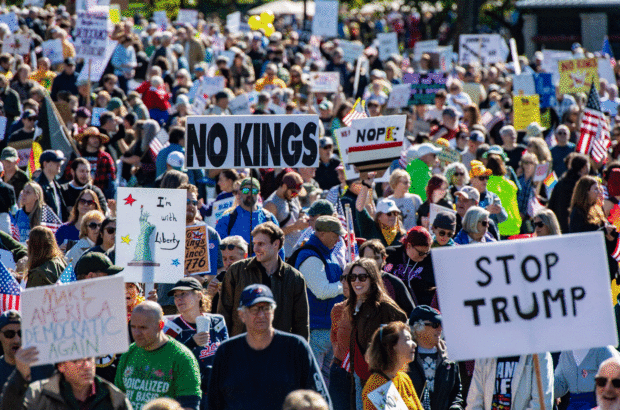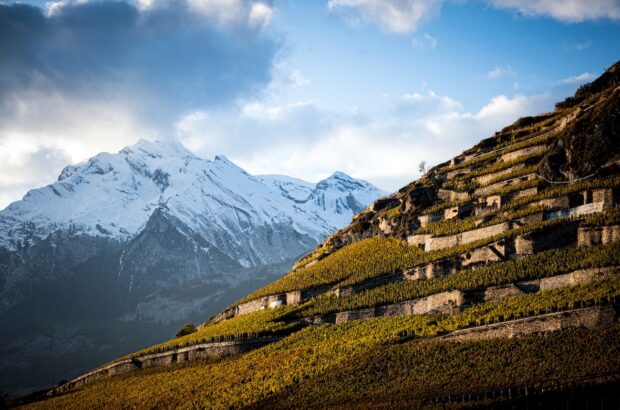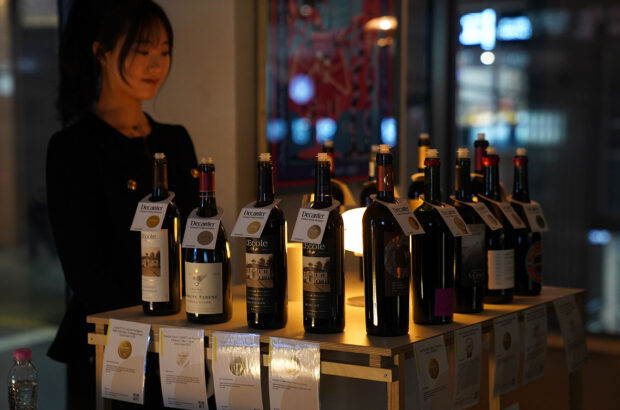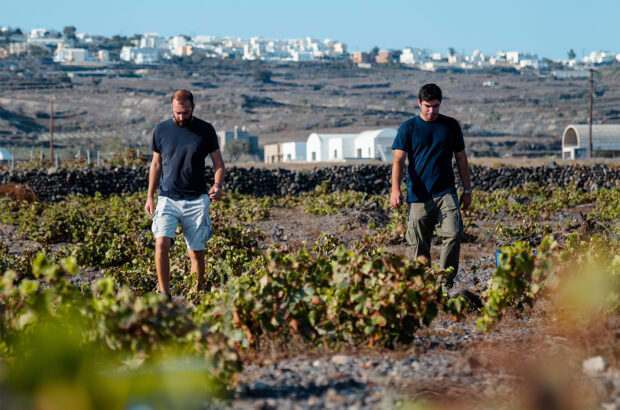Born in 1952 in La Morra, Roberto Voerzio grew up steeped in the rhythms of vineyard life. His father, Giacomo, began selling bulk wine in the 1930s and bottled his first Barolo after WWII – Voerzio still treasures a 1957 bottle bearing his father’s name. As children, Roberto and his siblings worked the land from an early age, shouldering heavy labour by their teens.
A string of hailstorms in the 1960s forced the family into factory work; Roberto’s first paycheque (‘37,800 lire, the equivalent today of about three pairs of shoes from the market’, he says) made him reconsider his path. Though he pursued chemistry studies at night, he left before graduating – drawn instead to a life of movement, rebellion and purpose.
‘At 14, I went to the municipal library in La Morra and picked out two books,’ he says, citing Sandokan, the Tiger of Mompracem and The Last of the Mohicans. ‘I was fascinated by epic feats, heroes, great leaders and courage.’
His passions – soccer, literature, and counterculture – merged with a growing fascination for Barolo. Early tastings of wines from Marcarini and Marengo Marenda, introduced by friends, left an indelible impression. It was then he resolved: if he ever made Barolo, it would be with fruit from La Morra’s most prized sites. That conviction remained intact even after two serious motorcycle accidents that hospitalised him throughout 1971–72.
His winemaking ideals were shaped by the region’s pioneers: Marcarini, Oddero, Conterno, Mascarello, Giacosa – and Gaja. These were his heroes, and their wines became the benchmark for his own relentless pursuit of excellence.

Roberto Voerzio sitting on his jeep in the Fossati vineyard in Barolo.
Q: What was it like working with your father, and what ultimately led you to strike out on your own and shape the legacy you’re building today?
Robert Voerzio (RV): In 1973, when I began working with my father and brother, tensions quickly surfaced. I wanted to change everything – buy prestigious Barolo vineyards, reduce yields, switch barrels. By 1986, after years of conflict, my wife and I founded our own winery, fuelled by vision, courage and deep gratitude that we were born in La Morra.
We saw each bottle of Barolo as a story – one that began long before us in vineyards farmed for generations. To honour that history, we often named wines after previous owners, preserving their memory. Remarkably, when we started buying vineyards in 1986, sellers often chose us not for the highest bid, but because they believed in our passion. Some even gave us two or three years to pay.
From the outset, we committed to natural farming – no chemical fertilisers, herbicides, systemic treatments or foliar feeds. We slashed yields: 500g per vine for Barolo crus, 300g for Barbera Pozzo dell’Annunziata, under 1kg for Dolcetto Priavino, Barbera Cerreto and Langhe Nebbiolo. We used traditional fermentations and bottled during the waning full moon in August. Our goal was ambitious: acquire Grand Cru vineyards across Barolo and replant at high density – 7,000 to 9,000 vines per hectare instead of the typical 2,500 to 3,000.
Q: Tell us about the vineyards you own and the vineyards you buy fruit from.
RV: Today, we farm about 35 hectares, 25 of which we own. Our Barolo Grand Crus include La Serra, Brunate, Cerequio, Rocche dell’Annunziata, Torriglione, Fossati, Case Nere and Sarmassa (in the Barolo commune), totalling around 15 hectares. We also produce two special Barolos: one labeled simply as Barolo del Comune di La Morra, made from Cerequio, La Serra, Fossati and Case Nere; and another called RV350, produced only in select vintages.
The 2019 vintage, now available, was made from Rocche dell’Annunziata and Case Nere. Its unique feature is that we harvest just 300 grams per vine – only 3 clusters instead of the usual 4 or 5.
Q: Are there any new vineyards you’re eyeing or any plots that you might be transitioning away from?
RV: At the moment, we have no intention of expanding the winery further, because the kind of vineyards we love simply aren’t available anymore. However, we’ve started a new project under the Barbera d’Asti denomination with vineyards in Nizza Monferrato and Canelli. In our region, they say Barolo is the king of wines and Barbera d’Asti is the queen. We loved the idea of working with this royal pair. These vineyards are of extremely high quality – we’ve already replanted 1.5 hectares at a density of 8,000 vines per hectare. The first harvest was in 2021, and we’re truly excited about it.

Roberto Voerzio’s Cerequio vineyard, overlooking the hills of La Morra in the background. Grapes planted here are Nebbiolo.
Q: Describe your winemaking style, from harvesting grapes to fermentation techniques and ageing regimens, and how this approach influences the final character of your wines.
RV: It’s the sum of many specific choices and processes that makes our wines unique – for their purity, elegance, finesse, richness, persistence and harmony. You’ll never taste oak, bitterness, or excessive alcohol in our wines. Every vintage tells a different story, shaped by the weather: a hot summer followed by a dry autumn leads to more powerful wines; but even so-called “lesser” years still yield excellent results.
Our style isn’t traditional – though we’ve preserved the best elements of tradition – nor is it modern. The modern approach often includes horizontal roto-fermenters, short 5–8 day macerations, and 100% new barriques, which we’ve never used. Ours is a style all its own.
Q: Your wines are often praised for their long ageing potential. Do you find this is a factor more of site or of winemaking?
RV: The extraordinary ageing potential of our wines comes primarily from the exceptional quality of our soils. Think about names like Cerequio, La Serra, Rocche dell’Annunziata, Fossati, Case Nere, Brunate, Sarmassa and Torriglione – these sites appear in municipal land records as early as the 1400s. Add to that natural vineyard practices, ultra-low yields that deliver concentration and intensity, and a simple, transparent approach in the cellar, and you have the recipe for long-lived wines.
Q: Who are the primary buyers of your wines, and where do you see the most demand coming from?
RV: Today, our main clients are serious wine lovers, restaurateurs, wine shops and collectors. The most dynamic markets are Japan, South Korea, the U.S., the UK, and a number of smaller countries that are just beginning to explore fine wine.
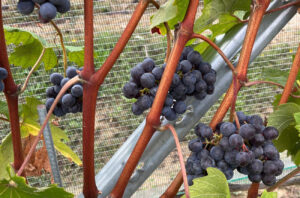
Locally, Barolo has been named the king of wines and Barbera d’Asti the queen.
Q: Could you give us a sense of your total production and how it has evolved over the years?
RV: In the early years, we produced about 30,000 bottles – 10,000 to 12,000 of Barolo and the rest Barbera, Dolcetto and Nebbiolo. Over the past 40 years, we’ve grown from 7 or 8 hectares to around 35, with 25 replanted at high densities of 7,000 to 9,000 vines per hectare. We now cultivate about 200,000 vines, producing approximately 90,000 bottles annually, along with 5,000 magnums (1.5L), 2,000 double magnums (3L), and a few hundred bottles of 6 and 12 litres. On average, we get just over half a bottle per vine.
Q: Looking ahead, what are your plans for the future of your winery? Are there any changes or new directions you’re considering?
RV: The 40 years behind us have been foundational but not enough. You have to keep proving yourself. That requires the same enthusiasm and drive we’ve always had. There’s little left to change: we’ve reached an incredibly fine-tuned rhythm in everything we do. Still, one exciting dream would be to own 4 or 5 hectares in Montalcino to produce 10,000 to 15,000 bottles of Brunello.
Alongside Barolo, we consider Brunello one of the greatest red wines in the world. We released our first Barolo from the 1987 vintage in 1991, at 17,000 lire per bottle. Back then, 100,000 lire per bottle seemed like a fantasy. But by staying true to our vision of absolute quality, without compromise, we’ve gone well beyond that dream.
WINES
Roberto Voerzio Dolcetto d’Alba Priavino 2023
93pts
Aged entirely in stainless steel, the Priavino Dolcetto d’Alba offers pristine aromatics of candied red berry fruit and rose petal florals, reaching a crescendo on the medium-bodied palate with notes of strawberry panna cotta. Robust tannins grip every corner of the palate before resolving through juicy acid tension. Good length, with a lovely dried Mediterranean macchia herb character lingering on the finish.
Alc 12.5%
Roberto Voerzio, Barbara d’Asti Superiore 2022
93pts
Aged for 12 months in large botti and small barriques, with no more than 30% new oak. It opens with bright cranberry and raspberry fruit and high-toned aromatics, layered with vanilla bean character and positively bracing, soaring tannins that etch the palate. The wine is lean, mean, bright and expressive, with crunchy acid tension that emerges after a tussle with those robust tannins. Give this a proper decant and enjoy it alongside any Italian dish you desire.
Alc 14.5%
Roberto Voerzio Barbera d’Alba Il Cerreto 2022
94pts
The 2022 Il Cerreto (a west-facing hillside site below the winery) Barbera d’Alba is an aromatic wonder, with notes of spearmint, sage, dried thyme, underbrush and cedar wood. The palate delivers stunning savoury intensity, with a sprinkling of black sea salt ingrained in the ultra-fine tannins. A long, resonant finish carries black tea, soaring saline acidity and crunchy fruit through to a seemingly everlasting close.
Alc 14%
Roberto Voerzio Nebbiolo Disanfrancesco Langhe 2022
94pts
A ruby-fruited, brown-spiced wine with elegant, fine-grained texture and a velvety quality that’s hard to match. Layers of ironstone minerality fuel the long, tension-filled finish.
Alc 15.5%
Roberto Voerzio Barbara d’Alba Pozzo dell’Annunziata 2021
97pts
A remarkable wine. Tasted from magnum, it offers some of the most elegant and opulent aromatics – like stepping into an old New York brownstone with rich mahogany mouldings – woven around dark cherry fruit, fig, dark chocolate and sea salt. Medium- to full-bodied on the palate, it shows remarkable depth and tension, with loamy earth notes, dark cassis fruit, and structured, velvety tannins framing emerging tones of tobacco, cigar and cherry stone. It’s profoundly youthful yet already layered and complex. Drink now if you must, but do try to cellar it for several years in a cool, dark place – it will reward your patience handsomely.
Alc 13.5%
Roberto Voerzio Barolo Cerequio 2012
96pts
Aged for 24 months in large botti and barriques, and made entirely from free-run juice, the 2011 Cerequio – tasted in late June 2025 at 13 years of age – is an absolute showstopper. All the secondary characteristics of mature Italian wine lift from the glass with a seductive power that could easily convert anyone to a lifelong devotee of Italian reds. Notes of black truffle and rich mahogany wood enrobe dark cherry and loamy earth. Medium-bodied on the palate at this stage, with emerging spearmint and lovely chocolatey tannins, nuanced by cumin, coriander and saffron. A medium-roast, round espresso note emerges on the finish, accented by pressed wild flowers and wild herb character. Just a truly lovely and gorgeous wine.
Alc 14.5%
Roberto Voerzio Barolo Case Nere Riserva 10 Anni 2015
97pts
First released in 2025, this wine offers rich, high-toned cranberry and cherry fruit, layered with brown baking spices, liquorice and ripping tannins that etch themselves into every corner of the palate. For all its time in the bottle, it still needs time! But open and decant it and let all those aromatics support a lovely purity of red-toned fruit and rich cedar wood spice, culminating in a lengthy finish marked by rose petal, iron and earth.
Alc 14.5%
Roberto Voerzio Barolo Rocche dell’Annunziate 2019
95pts
Immensely powerful and concentrated, yet remarkably light on its feet. It opens with heady incense notes, cranberry and cherry fruit, black olive and olive stone, followed by liquorice, tar and dried rose petals. There’s a striking purity of fruit and juicy acid tension, though the soaring tannins are still cloaking much of it in the wine’s youth. Give it time – or decant the hell out of it – and savour every bit of its savoury nuance.
Alc 14%
Roberto Voerzio Barolo Fossati 2020
95pts
Offers a distinctly Italian elegance – the kind that comes from spending mad money in the finest high-end boutiques of Florence. It evokes rare leather and aged tobacco of the sort the 1% might pay a small fortune to own. Rich forest berry and woodland spice rise from the glass, joined by crunchy cherry fruit and muddled raspberry. The medium-bodied palate is framed by leathery, tobacco-tinged tannins and an iron-like mineral presence. The finish lingers like a night out after a Michelin-starred Italian meal. Approachable now, yet undoubtedly age-worthy.
Alc 14.5%
Roberto Voerzio Barolo Rocche dell’Annunziate 2021
96pts
A profoundly structured wine with immense concentration of cherry and blood orange fruit, underpinned by stark wet stone minerality and tannins like skyscrapers, framing nuances of cherry wood, dried raspberry, leather, tobacco and spice. It cannot be understated: this is a baby of a wine, with the kind of powerful, tightly knit structure built to age for decades. In time, it will reveal a wealth of fruit, floral and herbaceous flavours and aromas but for now, as of June 2025, it remains coiled and full of tension.
Alc. 14.5%
Roberto Voerzio, Barolo Cerequio 2021
96pts
A powerhouse – dynamic and laser-focused – offering up crunchy red berry fruit and brown baking spices, with pomegranate seed nuances and layers of tobacco, tar, fragrant rose petal and rose stem. It’s tightly wound and coiled, with tremendous tension and just the first hints of fragrant, savoury dried sage and underbrush beginning to emerge.
Alc 14%
Roberto Voerzio, Barolo La Serra 2021
97pts
A spearmint-driven, sagebrush-layered wine, scented with cherry fruit and enriched by mahogany wood, pine forest, tar and tobacco notes. It offers medium-bodied richness of fruit and spice, all wrapped in a dynamic, brooding frame. This is a wine intent on retreating before it reveals its brilliance – suggest popping corks well after 2027.
Alc 14%
Roberto Voerzio Barolo Fossati 2021
96pts
The most approachable of the Roberto Voerzio 2021 wines tasted in late June 2025. Like its 2020 predecessor, it exudes distinctly Italian elegance – the kind born of spending lots of money in Florence’s finest boutiques. It’s all leather, tobacco and cherry fruit – the sort of leather a New York Yankees pitcher would kill to own. Loads of pomegranate seeds and cherry stone character mingle with Mediterranean macchia notes, expanding across a lengthy and generous finish.
Alc 14.5%
Roberto Voerzio Barolo Brunate 2021
96pts
Aromatics of crushed cocoa nibs, black cherry and raspberry fruit, with medium-roast ground espresso and a spearmint character. Pomegranate seed notes frame the soaring, gripping tannins, which carry a distinct mineral intensity. A lengthy, bone-dry finish offers a snapshot of some of the purest, juiciest most fleshy cherry fruit you could ever hope to encounter in life.
Alc 14%
Roberto Voerzio Barolo Sarmassa 2018
98pts
Poured from magnum, the 2018 Sarmassa opens with a savoury nose of sagebrush, dried spearmint, tobacco, leather and pomegranate seeds. Medium-bodied and deeply layered, it delivers impressive concentration of black cherry fruit scented with incense, and unfolds with blood orange, crushed cocoa nibs, rich mahogany wood, vanilla, tar, dried rose petals and dark loamy earth – all accented by a sprinkling of crushed medium-roast espresso beans. Long, layered, energetic, and masterfully crafted.
Alc 14%
Roberto Voerzio Barolo Torriglione 2020
97pts
Tasted from magnum, this wine is juicy and pure-fruited, with notes of cherry, blood orange, cranberry and pomegranate seed. There’s an impressive warming richness on the palate, with layers of brown baking spices, underbrush, leather, and dried roses and violets. Emerging notes of black tea and orange zest carry through the lengthy, everlasting finish. Whispers of incense add layered intrigue to this medium-bodied, expressive and powerfully structured red.
Alc 14%
Scores were generated as part of a non-blind tasting conducted for the purposes of the advertorial.





